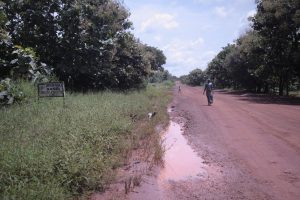The 14th Conference of the Parties (COP 14) to the Convention on Biological Diversity is taking place in Sharm El-Sheikh, Egypt, from the 17th to the 29th of November, 2018. Amongst other things, delegates are discussing a moratorium on the release of gene drives, a powerful genetic extinction technology.
Target Malaria, a $100 million project from Imperial College in London, UK, is the poster child of the gene drives proponents. The Target Malaria team intends to first release GMO mosquitos and then high risk Exterminator drive mosquitos in West African villages, with the unproven promise that the technology will soon eliminate malaria. Civil society from Africa and around the world is at COP 14 to demand that governments prevent the release of gene drives and that Africans should not be guinea pigs for unproven and risky technofixes.
Over 30 African civil society organizations urge African governments to support a moratorium on gene drives: „We are alarmed at what is going on at COP 14 and how our concerns are being betrayed and threatened by delegates from some African nations.“
Zahra Moloo travelled to Burkina Faso for an independent investigation and to gather different perspectives from villagers about what they understand of the project and what their concerns are. Here is her report:
In August 2018, Burkina Faso’s National Agency on Biosecurity (ANB) gave its official authorization for Target Malaria, a research consortium funded by the Gates Foundation and the Open Philanthropy project, to release 10 000 genetically modified “sterile male” mosquitoes in two villages: Bana and Sourkoudingan. Target Malaria’s project aims to use CRISPR-Cas9 technology to create a gene drive in malaria-carrying mosquitoes, a technology that spreads through the population, eventually rendering the species extinct. The release of the 10 000 “male sterile mosquitoes,” which are not yet gene drive mosquitoes, is the first stage in this experiment toward releasing the gene drives in the wild. The project is highly controversial. In the months prior to the announcement, civil society groups and activists in Ouagadougou organized a demonstration bringing together farmers and groups from Senegal, Burkina Faso, Côte d’Ivoire and Benin to protest Target Malaria’s gene drive experiments and other forms of genetic modification in a country that has already been the subject of failed experiments with genetically modified BT cotton. These groups also objected to being used as “guinea pigs” for western experimentation.
More information on Gene Drives: Gene Drives are artificial genetic systems inserted into sexually reproducing organisms, which are designed to pass on a specific, engineered trait to their offspring — and all subsequent generations of offspring. The effect of a functioning gene drive inserted into an organism is that the genetically engineered trait will quickly spread, by design, throughout a population in order to alter the population or cause it to become extinct.
Most journalists that have written or published reports about the gene drive mosquitoes visited the villages targeted for the release accompanied by Target Malaria rather than independently. In early October, Ali Tapsoba from the organization Terre à Vie, Issouf Sanou from the peasant group FENOP (Federation Nationale des Organisations Paysannes), a cameraperson, and I travelled from Ouagadougou to Bobo-Dioulasso. We wanted to do an independent investigation and to gather different perspectives from villagers about what they understand of the project and what their concerns are. Our findings indicate that many people in Bobo-Dioulasso, Bana and the neighbouring village of Nasso, are concerned about the potential impacts of Target Malaria’s project and about the absence of risk assessment, and are unaware of many of the details of the project, including where the funding for the project comes from.
Bobo-Dioulasso
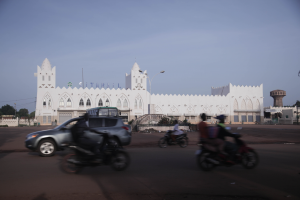
The city of Bobo-Dioulasso in southwest Burkina Faso is the capital of the Hauts-Bassins region and the second largest city in the country, a six-hour drive away from Ouagadougou. We met with some of the regional authorities in Bobo to hear what they thought of Target Malaria’s project. The governor, Antoine Aliou, spoke with us briefly. He was not comfortable speaking on record and said merely that malaria is a serious problem in the region and that the government is open to finding solutions to fight it.
Christophe Sanou is the Mayor of Arrondissement 5, which includes Pala, a village that was initially marked for the mosquito release. He said that Target Malaria had gone to Pala without first coming to his office to inform him of their project and to tell him their plans to visit the village. He wanted to know what would happen once the sterile male mosquitoes were released into the wild and added that his concerns were shared by all the counsellors of the district.
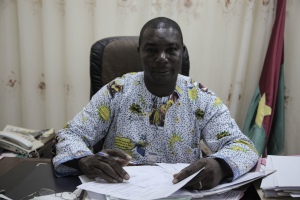
Activists and civil society groups based in Bobo also seemed to be in the dark about the project. One group, the Coordinating Body of the Women of the Hauts-Bassins region, represents several thousand women in the region. They said that they learned about Target Malaria’s project through a workshop organized by the group Collecif Citoyen pour Agroéocologie (CCAE) in July 2018. They had numerous concerns about the project, not least of which was the lack of awareness and consultation. They believe that raising awareness and engaging with the population is the minimum that Target Malaria should do. Like the mayor of Pala, they wanted to know what risks existed and what would happen once the mosquitoes are released into the world.
“That day (of the workshop), people unanimously rejected the arrival of these male mosquitoes. We do not know what is going to happen to them after the experiment…I would say leave us with our female anopheles mosquitoes, we will be able to handle them ourselves.” – Member of the Organizing Committee/Coordinating Body of Women from the Hauts-Bassins region
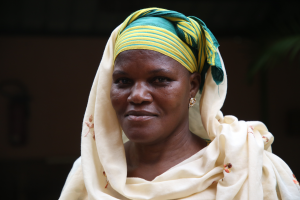
Douda Kambe Ouattara is the president of Y’en A Marre based in Bobo, a group that was created when the country’s previous government was overthrown in 2014. Y’en A Marre first began as a movement of rappers and journalists in Senegal. Like others we spoke to in Bobo, Ouattara knew little about Target Malaria’s project. He said he heard about it through word of mouth on the street until he too attended the workshop organized by the CCAE. According to him, Target Malaria has only spoken to the habitants of the villages targeted for release and not to the population of Bobo-Dioulasso. This remains a serious source of concern to him: that the project has already significantly advanced, yet the details remain unknown to the majority of the population indicates to him that “something is being hidden.”
It’s not just the targeted village which is important, it’s the whole region, even the whole country. When people from Bana say that what’s happening in their village does not concern others, it’s not true. They cannot confine the mosquitoes to remain in the village. When people come to test them out such projects, generally there’s a lot of funding involved. We would like more information about the project…as it’s the first experiment of its kind and it’s starting here with us, it’s worrying. To be the guinea pigs of this kind of experiment is worrying – Douda Kambe Ouattara, Y’en A Marre
Ouattara added that it had been difficult for them to reach people in the communities. Indeed, our own inquiries found that journalists who had attempted to reach the village of Bana and Sourkoudingan independently of Target Malaria were unsuccessful.
Bana, Sourkoudinguan and Nasso Villages
The day before we set off to visit Bana village, Ali Tapsoba called the village chief to inform him of our visit. A few months ago, Tapsoba and some of his colleagues from the Coalition pour la Protection du Patrimoine Génétique Africain (COPAGEN) met with the village authorities in Bana. At first, the chief agreed to meet us, but the morning of our visit, he told us not to come as there were cultural celebrations taking place in the village. Tapsoba mentioned that as we had come from Ouagadougou, we would pass by briefly. The mayor of the seventh district, which includes Bana village, advised us to visit the village accompanied by his chauffeur.
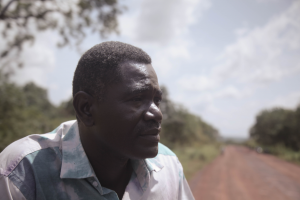
Bana lies 18 kilometres away from Bobo. Upon reaching the village, the CVD (the head of the village committee for development) and a young man whom Tapsoba had met earlier in the year and who had been recruited by Target Malaria to catch mosquitoes, came to tell us that we should leave. The chauffeur explained that we want to meet the chief and speak to him, but they refused. We were told to leave the village. Both Tapsoba and Issouf found this type of hostile reception to be strange and extremely rare in Burkina Faso.
Having been refused entry to the village of Bana, we made our way to Sourkoudingan, the neighbouring village marked for the mosquito release, a few kilometres away. We were warmly greeted at the entrance to Sourkoudingan, and made our way to the chief’s house to meet him and obtain permission to speak to the village inhabitants. Outside his house, a Target Malaria poster was affixed to a tree. As we approached, a group of young men appeared and threatened to burn down the car. They were categorical that we should leave and that we could not meet the chief or speak to anyone. We made our way back to the entrance of the village where a tense exchange erupted between these men and the people who had welcomed us before. Later, we heard unverifiable rumours that the villagers had received a phone call from Ouagadougou telling them not to speak to us or allow us to come into the village.
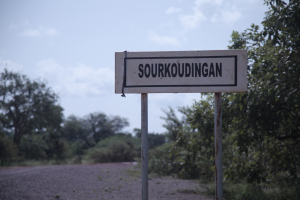
Some days later, the mayor of Bana intervened again in order for us to be able to enter the village. I went back, accompanied by the mayor’s counsellor, Gigue Abdullahi Sekou, and a member of the citizens’ movement, Balai Citoyen. We met with the CVD, the young mosquito capturer, the village chief and the customary chief. During a filmed interview with the customary chief, he asked whether we had gone through Target Malaria before coming to the village. About half way through our interview, we were told that the interview was over and he had nothing more to say. Although Target Malaria’s own risk assessment states that the “first generation” sterile male technology… is unlikely to be used for malaria control in Africa,” both the chief and customary chief of the village believed that the release of 10 000 genetically modified “sterile male” mosquitoes would lead to a reduction in malaria.
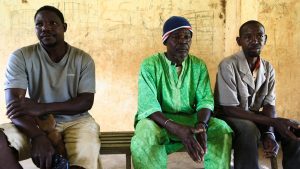
After our exchange with the village chief, we were still not permitted to speak to other people in the village. We drove a distance away and visited the house of the mayor’s counsellor. Here we managed to speak with some inhabitants of Bana that live away from the village centre.
The farmers that we spoke to in Bana[1] did not know much about the project and some expressed concerns about it. One said he learned about the project through the television and on the radio; he was not present at the village gathering earlier in the year when he said the project was discussed. His understanding of how the technology and the project worked was limited:
“They said they would capture the mosquitoes, make them sterile in Europe and when they are brought back, when the sterile male mosquitoes bite other mosquitoes that have not been modified, they will also become sterile. So even if they bite you, you don’t get malaria.” – Farmer from Bana Village
Another farmer and resident of Bana, said that no one from the project had come to explain to her how the project works. All she knew was that mosquitoes were being captured in order to reduce malaria. She explained that most of the project’s activities took place at the centre of the village, and as she lived further away, she was not involved. The mayor’s counsellor, Gigue Abdullahi Sekou explained that the village authorities signed off on the project on behalf of the rest of the village, after a public assembly was held. A poultry farmer was asked if the village chief had signed off on the project with his consent. He said as he was far from the centre of the village, he was not aware of it.
I did bring this problem up with Target Malaria. I told them to take measures so that the entire village is involved. For instance, regarding the young people who capture the mosquitoes, they should also recruit young people from other areas of the village so that the information gets around. If you see that people are resistant to doing interviews, it could be because they are afraid to lose the little benefit they get from the project. Target works with the village leaders and they relay the information to the rest of the village. I tried to tell Target to have teams to go around in small groups and talk to people and they said they would start doing that. It seems it wasn’t done, and I don’t really know where things are at now. – Gigue Abdullahi Sekou
None of the people we spoke to had seen or signed any consent forms, or were aware that the project’s final objective was to render the malaria-carrying mosquitoes extinct. They were also unaware of potential risks and they believed that the 10 000 male sterile mosquitoes that were being released in the first phase would have the effect of reducing malaria in the village.
Another farmer said that those who were working as mosquito capturers with Target Malaria, which he estimated to be between 10 and 20 people, were given medical treatment if they ever caught malaria, but those who did not work with the project did not receive treatment. The benefit of those working as mosquito capturers, he said, was that they could earn a small amount of money.
If I am not able to understand, I cannot give my consent, because I do not know what damage will be caused by these mosquitoes. In any case, it makes me afraid because I don’t know what is going to happen. They have gone to make sterile mosquitoes, but what will result from that? I really don’t understand. – Farmer, Bana Village
One issue that raises serious ethical concerns is the way in which mosquitoes are captured by the Target Malaria team for experimentation. A counsellor from the village neighbouring Bana, Nasso, said that his cousin who lives in Bana village was used as a “guinea pig” to catch mosquitoes – in other words, he would have to sit in a chair and catch the mosquitoes as they landed on his skin. He subsequently caught malaria. Although the counsellor said he did not know if the malaria was contracted from the experiment, his cousin was nonetheless advised by his relatives to stop participating in the experiment. He asked Target Malaria inquired whether using people as ‘guinea pigs’ as they did with his cousin could cause problems, and they were told that no problems would be caused, and that the experiments was required for research into funding solutions for malaria eradication. Like all the others we spoke to, the counsellor expressed concern about “secondary effects” from the mosquito modification.
A resident of Bana village who met with us in Bobo was very much in favour of the project. He said he was not aware of any risks in the process. He described the mosquito catching process:
“After having captured the mosquitoes with cloth, they brought small tubes and gave them to people for capturing at 8, 9, 10 and 11 pm starting from 8 o clock pm. You sit in a chair and stay there in one place. When a mosquito comes and sits on you, you don’t kill it, you do all that you can to catch it in the tube, then you put it aside. From 8 to 9 pm, the mosquitoes that you capture in the tubes, you don’t mix them. The 9 o’clock tubes are put aside, the 10 o’clock tubes are also put aside. There is one hour between each capture and then the tubes are separated. I personally would never accept to sit and capture mosquitoes. But I know that those who do it are paid, because at the end of each month, they receive money. Concerning the funding [for the Target Malaria project], we are not able to say where it comes from and to be used, we don’t know anything about that. – Resident of Bana village
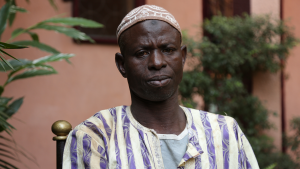
Nasso
Nasso, the neighbouring Bana, lies about 5 kilometres away from Bana and has a population of an estimated 3365 people. Sanou Simplice, the president of Nasso village said that people from Target Malaria came to Nasso to talk about their work in June 2017. The seven people who were present during the exchange asked Target Malaria what consequences would result from the experiments and the project officials explained that as it was an experiment, the results would reveal more information.
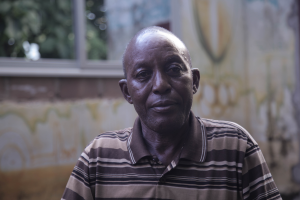
“We saw what happened with Monsanto – modified organisms always leave traces…since they are doing research, we will see what happens with the next steps.” – Sanou Simplice, Nasso
Simplice also asked Target Malaria if the technology had been tested before, and they responded that the reason why it was being tried in Burkina Faso was because it has been tried out elsewhere and gave convincing results. A primary school teacher that we spoke to in Bobo suggested that the reason why risk assessments have not been spoken about by Target Malaria is because the technology is said to have been “well mastered.” This seems to contradict what many people we spoke to were not aware of, that a gene drive has never been released into the wild before; how it will fare in nature outside the laboratory is yet unknown.
Simplice from Nasso village also said that they were told that the release of mosquitoes in Bana would not affect the village of Nasso. This, too, is a questionable claim since there is significant movement between the two villages as they are located very close together.
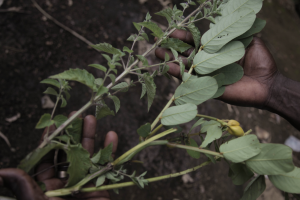
In their promotional material, Target Malaria claims that they approach the project in a way that ensures that “human well-being and environmental considerations are fundamental.” They say that they work with local communities and take their concerns into account: “No part of the project goes ahead without this consent.” As our investigations have revealed, the project has only taken into consideration the consent of a small group of leaders in the central area of the targeted community of Bana, and the process through which their consent was obtained is still unknown. Our investigations into the way in which mosquitoes have been captured, asking villagers to use their own bodies to catch malaria-carrying mosquitoes and exposing themselves to malaria, reveal that contrary to the project’s claims, “human well-being” is not being taken into account. Target Malaria claims that their stakeholders “have a right to understand what we do and to decide whether to support us,” yet people we spoke to in Bobo-Dioulasso, Bana and Nasso, either did not understand the project well or at all, and had a number of concerns which have not been addressed. Instead, Target Malaria’s project has generated a great deal of controversy and as we found during our trip, is shrouded in secrecy.
[1] As the project is controversial and people are reluctant to speak on the topic, the names of the farmers interviewed in Bana have been withheld.
Pictures in this article by Olympia de Maismont, Boubacar Balde and Zahra Moloo.

